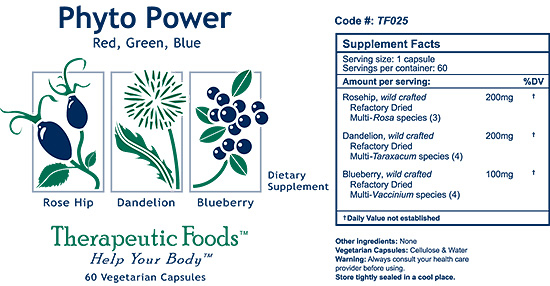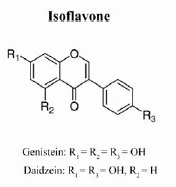Most Studied Flavonoid: IsoFlavones
|
Dear Friends,
In this week’s newsletter we will close out our discussion of the flavonoids—which we began with the anthocyanins back in the January 18th Forward Thinking—by looking at perhaps the most widely studied of the flavonoid groups—the isoflavones.
Phytoestrogens, such as genistein and daidzein, can act both as aids in reducing hot flashes in menopause, and bone loss in postmenopausal women by increasing estrogen stimulation; while at the same time reducing the incidence of cancers caused from excess estrogen by reducing estrogen stimulation. How can that be? How can you have it both ways? One possible answer is through understanding the concept of alpha and beta estrogen receptors. In the ’80s scientists discovered the alpha and beta receptors for estrogens. The alpha receptors are associated with the initiation of the development of estrogen related cancers and the beta receptors are associated with the good effects of estrogen. Different tissues appear to have different ratios of these two receptors. The beta-receptors, which exercise favourable effects for health, can be found mainly in the blood cells, the lungs, the prostate, the bladder, bones and thymus. Isoflavones stimulate their function even after the level of estrogens has decreased. The alpha-receptor can be mainly found in the breast tissue, the uterus, the ovaries, the testicles and the liver. In those places, isoflavones protect the receptor against estrogens and help reduce the proneness to tumors. (Isoflavones.info) It seems that we are inferring here that isoflavones behave differently in regards to alpha and beta receptors, whereas with beta receptors these phytoestrogens are strong enough to enhance the estrogen effect and with alpha receptors they block the estrogen effect. I need further illumination on this point. Your feedback is always appreciated. Benefits of isoflavones: American’s breast cancer rate is 22.4 per 100,000 people, which is nearly four times Japan’s rate of 6 per 100,000. America’s prostate cancer rate is 15.7 per 100,000 people, yet again four times Japan’s rate of 3.5 per 100,000. The Japanese consume 30 to 50 times more soy product than do Americans … When the urinary excretion of certain phytoestrogens found in soy—primarily genistein and diadzen— were measured … the Japanese women excreted 2,000 to 3,000 nanomolar per day, and the American women, 30 to 40 nanomolar per day … The soybean abyss is probably the most dramatic difference between the Japanese and American diets (Gaynor M. et al 1999). Genistein has been shown to possess a wide variety of activities using in vitro animal cells and in vivo animal models, including tyrosine kinase inhibition, chemoprevention of breast and prostate cancer, prevention of cardiovascular disease and amelioration of postmenopausal ailments (Nutritional Genomics 2011 pg 117). Tyrosine kinase is an important cell-signaling molecule that when activated, helps confer immortality on cancer cells (Dr. Gaynor’s Cancer Prevention Program 1999 pg 94). Isoflavone phytoestrogens such as genistein from soy … may protect against the possible carcinogenic actions of estrogen by … inhibiting the production of estrogen by the enzyme aromatase … [and by] competing at the estrogen receptor level, with either estrogen or xenoestrogens (industrial and agricultural chemicals such as bisphenol A and pesticides), which have potent estrogen-like and carcinogenic activities (Forever Young 2010 pg 201). In a 1989 study of 8,000 Hawaiian men of Japanese ancestry, those who ate the most tofu had the lowest rates of prostate cancer. A shanghai study found that women who seldom ate soy foods had twice the rate of breast cancer of those who ate soy frequently (Gaynor, pg 97). Scientists compared the blood levels of soy isoflavonoids in Japanese men with those of Finnish men, who have higher rates of prostate cancer. The Japanese men’s blood contained from 7 to 110 times as much isoflavonoids, suggesting that the higher levels protect men from prostate cancer (Gaynor, pg 98). So, we’ve look at Vitamin P (the Flavonoids) and their health promoting attributes, since January. We’ve seen how even though they are structurally very similar, small differences in each of the flavonoid subgroupings’ molecular structures make for many varied and necessary functional benefits critical for our body’s health. In the coming weeks we will look at Vitamin Q and Vitamin U, and other phytochemicals whose dietary inclusion arms our bodies with the nutrients necessary for our robust health in our world today, and to enhance our physical ability to fight the good fight. Sincerely yours, Seann Bardell Clinical Note: I would like to introduce you to our newest Therapeutic Foods product: Phyto Power. It is a product that contains many of the powerful health building flavonoids that we have been looking at over the last while. It represents the ultimate in BioImmersion’s goal to give you absolutely clean, natural, organic, high active products. I will devote next week’s Foreward Thinking to a proper introduction; but, just to give you a taste here I’ll show you the label. We’ll fill in the details next week. You’ll be amazed. 
|


 Isoflavones are found in abundance is soybeans, soy foods and legumes. They are a class of phytoestrogens. Three of the isoflavones are genistein, daidzein and glycitein. To the right is genistein. Notice the molecular differences between the three: Daidzein does not have an OH on top of the left hand phenol, otherwise it is exactly the same as genistein. Glycitein has no OH like Daidzein but has a H3CO coming off the left phenolic.
Isoflavones are found in abundance is soybeans, soy foods and legumes. They are a class of phytoestrogens. Three of the isoflavones are genistein, daidzein and glycitein. To the right is genistein. Notice the molecular differences between the three: Daidzein does not have an OH on top of the left hand phenol, otherwise it is exactly the same as genistein. Glycitein has no OH like Daidzein but has a H3CO coming off the left phenolic.

